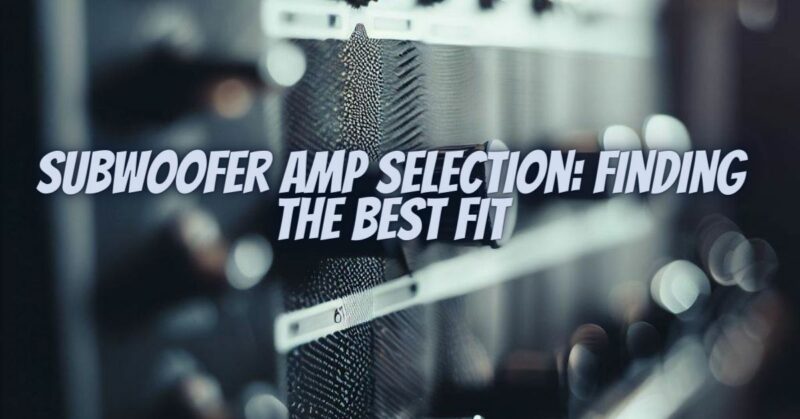Selecting the right amplifier for your subwoofer is a crucial step in building a high-quality audio system. The amplifier you choose should match the power requirements and specifications of your subwoofer to ensure optimal performance and sound quality. In this article, we’ll explore the key factors to consider when selecting a subwoofer amplifier to find the best fit for your audio setup.
Understanding Subwoofer Amplifiers
Subwoofers are passive speakers, meaning they lack built-in amplifiers like most full-range speakers. As a result, they rely on external amplifiers to provide the power needed to produce deep, low-frequency bass. Subwoofer amplifiers play a vital role in the audio chain by amplifying the low-level audio signals and driving the subwoofer’s speaker effectively.
Key Considerations for Subwoofer Amp Selection
When choosing an amplifier for your subwoofer, consider the following factors:
1. Power Rating (RMS):
- Match RMS Ratings: The RMS (root mean square) power rating of your subwoofer and amplifier should match or slightly exceed each other. This ensures that the amplifier can supply the necessary power without straining or risking damage to the subwoofer.
- Subwoofer Power Handling: Check the subwoofer’s power handling capacity to determine the appropriate amplifier power. Using an amplifier with too much power can overpower the subwoofer and cause damage.
2. Impedance Match:
- Compatibility: Ensure that the amplifier’s output impedance matches the subwoofer’s input impedance. Mismatched impedances can lead to power delivery issues, affecting both performance and safety.
3. Room Size:
- Consider Room Acoustics: The size and acoustics of your listening room play a role in amplifier selection. Larger rooms may require more powerful amplifiers to fill the space with deep bass effectively.
4. Subwoofer Type:
- Type Compatibility: Different subwoofer types (e.g., sealed, ported, bandpass) have varying power requirements. Choose an amplifier that suits the specific type of subwoofer you have.
5. Brand Compatibility:
- Manufacturer Recommendations: Some subwoofer manufacturers offer dedicated amplifiers designed specifically for their subwoofers. These amplifiers are often optimized for seamless integration with the subwoofer and can simplify setup.
6. Built-In Controls:
- Adjustment Options: Consider amplifiers that come with built-in controls and features for fine-tuning the subwoofer’s performance. These may include volume, phase, and sometimes equalization controls, allowing you to tailor the subwoofer’s output to your room and preferences.
7. Budget:
- Cost Considerations: Amplifiers come in various price ranges. Set a budget that aligns with your audio aspirations while taking into account other components of your audio system.
8. Amplifier Type:
- Class of Amplifier: Amplifiers come in different classes (e.g., Class A, Class AB, Class D) with varying efficiency and performance characteristics. Choose an amplifier class that suits your needs and budget.
Active vs. Passive Subwoofers:
It’s essential to differentiate between active (powered) and passive (unpowered) subwoofers when selecting an amplifier:
- Active Subwoofers: Active subwoofers come with built-in amplifiers and are designed as a complete unit. The amplifier is optimized for the subwoofer, simplifying the matching process. You only need to provide a line-level audio connection.
- Passive Subwoofers: Passive subwoofers require an external amplifier to provide power. In this case, you must ensure that the external amplifier matches the subwoofer’s power requirements, as discussed earlier.
Selecting the right amplifier for your subwoofer is essential for achieving optimal sound quality and performance. By considering factors such as power rating, impedance compatibility, room size, subwoofer type, brand compatibility, built-in controls, budget, and amplifier class, you can create a well-balanced audio system that delivers deep, powerful, and precise bass. A well-matched subwoofer and amplifier combination enhances your audio experience, adding depth and richness to your music and home theater setups.


